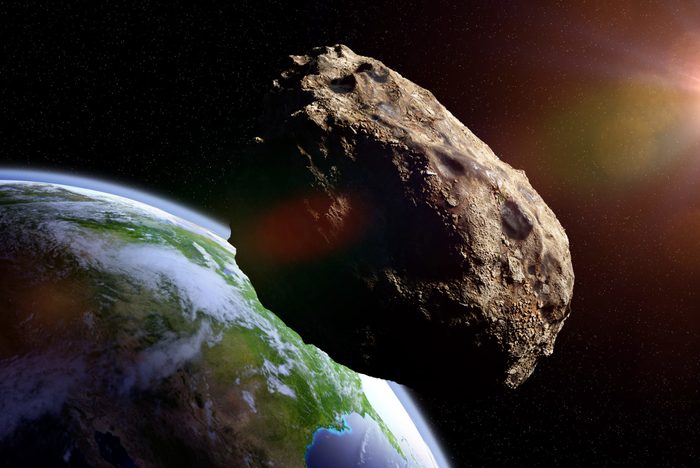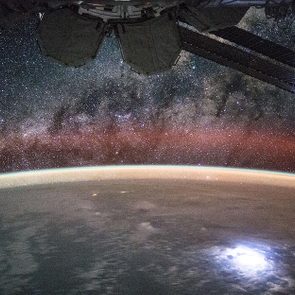What Could Happen If an Asteroid Hits Earth
Updated: Oct. 26, 2022

Some 66 million years ago, an asteroid wiped out 75 percent of life on Earth. What would happen if an asteroid landed today?
Dinosaur enthusiasts know that an asteroid hitting Earth’s Yucatan Peninsula 66 million years ago—actually, let’s define terms first: an asteroid is a piece of rocky space debris that remains in space; it’s called a meteorite when it survives entry into our atmosphere and hits Earth—is mostly responsible for ending the 180-million-year age of “fearsome lizards.” The 15-kilometer-wide meteorite hit land to make the 150-kilometer-wide Chicxulub crater and in the process, wiped out most dinosaurs, mammals, and marine and avian reptiles (although volcanic activity is also implicated in mass die-offs). Around the impact site, “there was total devastation,” according to the Natural History Museum in the United Kingdom. “A huge blast wave and heatwave…threw vast amounts of material up into the atmosphere,” effectively blocking the sun and causing a chain reaction that led to ecosystem collapse. That was then. What would happen now in an asteroid hit earth?
The effects of wind
For starters, it’s extremely unlikely. A threat-worthy asteroid hits Earth only once every 500,000 years, reports Vox. Nevertheless, scientists are keen to figure out potential scenarios, just in case. In 2017, a team of UK researchers published a paper in Geophysical Research Letters exhibiting possible outcomes based on 50,000 computer-simulated impacts at sites around the globe. The biggest threat to humankind for the size/density asteroids they simulated, as well as actual recorded encounters, was wind. Yes, wind. With the Chelyabinsk bolide event that happened over Russia 2013, when an asteroid disintegrated in midair, the researchers report, “Most of the damage and injuries…were caused by the aerodynamic shock that knocked people to the ground and damaged structures and windows, causing indirect injuries by flying glass shards.” And remember, this asteroid didn’t even hit the earth. The bigger the asteroid, the more likely it is to create the kind of wind that can level whole towns or even cities.
Beware thermal radiation
Another major threat to life from an asteroid comes from thermal radiation. In 1908, also over Russia, in Siberia, thermal radiation from the Tunguska event (yet another asteroid explosion before impact) felled 2,000 kilometers worth of forest and set fire to 300 kilometers worth of trees. Luckily, Siberia back then was a remote and pretty unpopulous place, so no human lives were lost. Although, the UK researchers did point out that “the released energy would certainly have sufficed to cause casualties in populated regions.” What’s the result of asteroids hitting out Moon? Scientists have answers for that, too.
Tsunamis
There’s been a lot of speculation about how many lives would be lost on Earth due to an asteroid creating tsunamis. And as the UK researchers discovered, tsunamis are a concern—but only if asteroids hit the ocean, which means they comprise 20 percent of the “overall threat of impacting asteroids.” Nevertheless, tsunamis would be the most devastating effects of an asteroid hitting the ocean, accounting for 70 to 80 percent of losses of life in that instance, depending on the size of the asteroid, the researchers say, and of concern for populations living near oceans, who might need to be evacuated. Learn the signs of a pending tsunami.
Flattened buildings
A large asteroid hitting the earth would wipe out life as we know it—you can watch a Discovery Channel simulation showing the fiery, Earth-destroying effects of dwarf planet Ceres hitting our planet. Back in 2008, How Stuff Works postulated about what would happen if even much smaller asteroids hit land. An object 200 feet in diameter would level reinforced concrete buildings within a 5-mile radius of impact, they reported, meaning a whole city the size of Paris could be wiped out if an asteroid landed in its midst. Why? Because an asteroid of that size generates up to 50 megatons of energy. Even a house-size asteroid would level buildings within a 1-mile radius of impact. You’ll want to check out these science “facts” that are actually not true.
Crop loss
The effects of an asteroid large enough to wreak havoc on Earth wouldn’t just be felt immediately; they’d reverberate over time. A NASA working group found, for example, that an asteroid larger than 2 kilometers could “degrade the global climate, leading to widespread crop failure and loss of life.” As Science reports, dust and debris kicked up by the impact would block out the sun; soot from wildfires would contribute to this blockage, and taken all together, “would cast the planet into a so-called impact winter, causing crop failures and mass starvation.” Don’t miss these science facts you never learned in school.
End of the world
It would take an asteroid that’s half a mile wide to get us to the end of the world as we know it. According to Business Insider, that would likely mean an asteroid the size of the one that killed off the dinosaurs, which would create a crater 100 miles across, vaporize life at the site of impact, send out earthquakes that could be felt for thousands of miles, and lead to those crop failures mentioned above. Basically, the end of most living things. An asteroid any bigger than that would actually slow the rotation of our home planet—but luckily, we wouldn’t be around to experience the effects of that. Next, read on to learn about 15 science mysteries no one has figured out.
Sources:
- National History Museum: “How an asteroid ended the age of the dinosaurs”
- Vox: “If you die via asteroid, this is how it will happen”
- Geophysical Research Letters: “Asteroid impact effects and their immediate hazards for human populations”
- Discovery Channel: “Asteroid warning: What would happen if huge asteroid hit Earth? The terrifying reality”
- How Stuff Works: “What if an Asteroid Hit Earth?”
- Science: “Here’s how the world could end—and what we can do about it”
- Business Insider: “Here’s how much damage an asteroid would cause if it hit Earth”






















